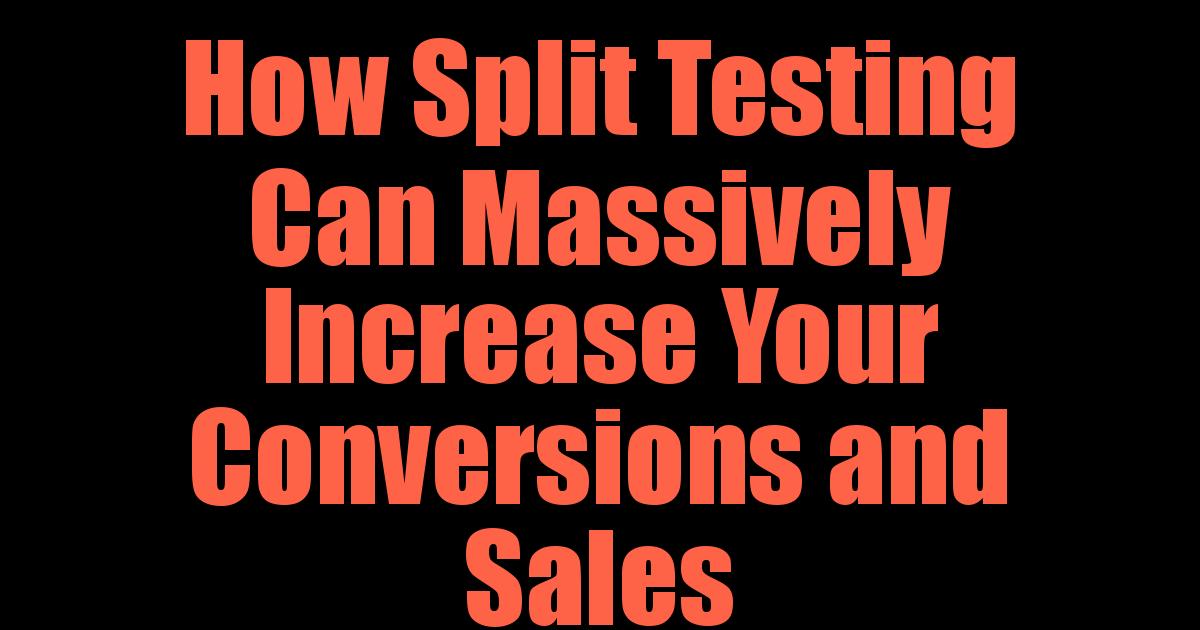 Too many business owners and marketers will only create one version of an offer, sales page, opt-in page, ad, etc., and simply hope that it works. If it does, they’re happy. If it doesn’t, they think that the offer simply doesn’t work.
Too many business owners and marketers will only create one version of an offer, sales page, opt-in page, ad, etc., and simply hope that it works. If it does, they’re happy. If it doesn’t, they think that the offer simply doesn’t work.
That’s a horrible way to go about it. If your first attempt doesn’t work, you’ll want to create several different versions of all of those to see if maybe it’s something in your sales copy. And even if you get lucky and get a winning offer right off the bat, you’ll want to constantly test new things in the sales copy to see if you can increase clicks to your ads, lead conversions to your opt-in pages, sales to your sales page, and upsells to your upsell pages.
It doesn’t have to be hard. Even just changing around headlines or little things here and there can often have drastic effects. For instance, you might find that changing a headline and shortening down the length of an opt-in page might boost your lead conversions from 20% to 30%. That alone could increase your sales by 50%! And by tweaking an upsell page just a bit, you might find that you move conversions there from 5% to 8%, which would be a 60% increase on the backend! Little changes can go a long way and can easily turn a loser campaign into a winner.
And the best part about all this is that little increases in conversions here and there can be responsible for massive increases in money made overall. But having said that, you want to be sure to focus your efforts first on the parts that make you the most money. For instance, improving your front-end conversion rates or those on your biggest money making upsell will almost certainly make you a lot more than focusing on your fourth upsell that doesn’t sell much currently (not to say you can’t improve that and make more, though).
One awesome free tool you can use is BizFire’s Funnel Maker, which you can get for free at www.bizfire.com/funnelmaker. This tool not only lets you build out funnels to simulate a real business, but it lets you see what happens when you increase or decrease conversions in various parts. It’s perhaps our favorite tool to play around with and plan out our businesses!
So make sure you are always testing new sales copy and upsells in order to see if you can increase your opt-in rate, sales conversions, or upsell conversions. Little changes can often have drastic effects that can turn a bad campaign into a winner.
And to check out the Funnel Maker software for free to see how even small changes can massively impact your conversions, click here BizFire's Free Funnel Maker & Analyzer.

 If you haven't tried Facebook ads already and you know a lot of people who have, you probably don't want to. They're uncharted waters, and many before you have failed. At least once or twice, sometimes even from business professionals, you've probably heard plain and simple that Facebook ads don't work. Everyone who tries just loses their money with minimal results. First, let's dispel that myth. Not everyone fails on Facebook marketing. It is a highly effective platform, but only if you succeed in utilizing it's tools properly.
If you haven't tried Facebook ads already and you know a lot of people who have, you probably don't want to. They're uncharted waters, and many before you have failed. At least once or twice, sometimes even from business professionals, you've probably heard plain and simple that Facebook ads don't work. Everyone who tries just loses their money with minimal results. First, let's dispel that myth. Not everyone fails on Facebook marketing. It is a highly effective platform, but only if you succeed in utilizing it's tools properly.
 Business to marketing seems like a foreign language to many people who are trying it for the first time. The consumer markets seems so much plainer and easier, after all, we're dealing with every day people. With businesses we feel we are dealing with some mysterious entity or some divine VIP, a thing whose persona is foreign to everything we knew in the every day human consciousness.
Business to marketing seems like a foreign language to many people who are trying it for the first time. The consumer markets seems so much plainer and easier, after all, we're dealing with every day people. With businesses we feel we are dealing with some mysterious entity or some divine VIP, a thing whose persona is foreign to everything we knew in the every day human consciousness.
 What is a Ranking in SEO?
What is a Ranking in SEO?
 You’ve probably bought electronics before and been offered the purchase an additional warranty. Or maybe you’ve purchased furniture before and been offered a white glove service to deliver and setup your new couch.
You’ve probably bought electronics before and been offered the purchase an additional warranty. Or maybe you’ve purchased furniture before and been offered a white glove service to deliver and setup your new couch.
 How can you improve your marketing and create new products - products that your customers already want? Simple. Ask for feedback from your customers and see what the common themes are. What do your customers like most about your product? How can you focus on that more in your marketing? What do they believe that your product/service currently lacks? Think about how you can use their feedback to create a new/improved service and offer that to your customers.
How can you improve your marketing and create new products - products that your customers already want? Simple. Ask for feedback from your customers and see what the common themes are. What do your customers like most about your product? How can you focus on that more in your marketing? What do they believe that your product/service currently lacks? Think about how you can use their feedback to create a new/improved service and offer that to your customers.
 Anyone who owns a website and publishes original content on it wants to see the site ranked higher on Google and other search engines. While many may believe that writing a top-quality piece of content, publishing it, and promoting it is enough to make the website successful, it is certainly not. In this era of fierce competition when thousands of websites are competing for the same kind of audience.
Anyone who owns a website and publishes original content on it wants to see the site ranked higher on Google and other search engines. While many may believe that writing a top-quality piece of content, publishing it, and promoting it is enough to make the website successful, it is certainly not. In this era of fierce competition when thousands of websites are competing for the same kind of audience.
